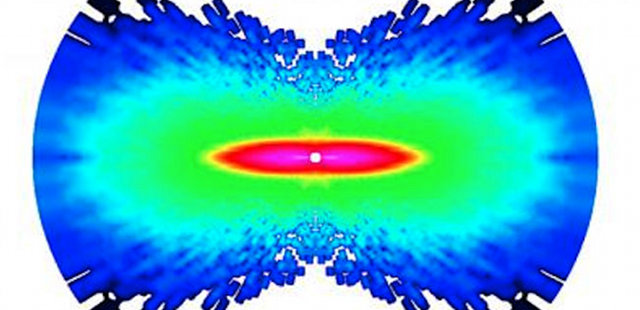 A nitrogen molecule shifts during the time between laser pulses, one femtosecond. The atoms' movements are shown as a measure of increasing angular momentum, on a scale from dark blue to pink, with pink showing the region of greatest momentum. IMAGE COURTESY OF COSMIN BLAGA
A nitrogen molecule shifts during the time between laser pulses, one femtosecond. The atoms' movements are shown as a measure of increasing angular momentum, on a scale from dark blue to pink, with pink showing the region of greatest momentum. IMAGE COURTESY OF COSMIN BLAGA
THE DEVICE: Molecules are in constant motion as electrons swarm around inside atoms, slightly flexing the atomic bonds and shifting the molecule’s shape. Using standard tools found in physical chemistry labs, physicist Cosmin Blaga from Ohio State University and his colleagues have executed a technique to take rapid snapshots of molecules in motion, published last week (March 7) in Nature.
By shooting a laser through a tiny hole into a vacuum chamber, Blaga created an infrared laser field. The laser’s intensity knocks an electron out of atomic orbit just for a few femtoseconds, or 10-15 seconds. In that short time before the electron...
Blaga compares the experiment to trying to learn a car’s shape by lobbing tennis balls at it. If you throw many tennis balls at a car from different directions, they will “scatter at different angles,” he said, depending on whether they hit the windshield or the trunk, for example. And using the information of “how those tennis balls scattered, you can recreate the image of the car.”

WHAT’S NEW: Researchers have tried to study the shape of molecules by observing how electrons scatter since Ernest Rutherford’s famous gold-foil experiments in the early 20th century, zapping molecules and atoms with X-rays and laser beams. More recently, researchers began shooting electron pulses at molecules, but the negative charges of the introduced electrons interfered with the readings, restricting the temporal resolution of the snapshots to a picosecond, or one trillionth of a second—far too slow to capture the detailed changes in molecular shape that researchers sought.
By pulling just a single electron from the molecule, Blaga and his team were able to shift the molecule’s shape without introducing any interference, allowing them to capture the much shorter femtosecond-scale shape shifts. “What they did is state of the art, pretty much,” said German Sciaini, who studies atomic resolution at the Max Planck Research Department for Structural Dynamics and was not involved in the research. “You can really see how this molecule is changing in time.”
IMPORTANCE: “Atoms move around very fast during a chemical reaction,” said Blaga, and “what we want to see is how they actually move and what path they take.”
The published research analyzed the movements of oxygen and nitrogen molecules, which have very simple, two-atom structure, as a “proof of principle of the technique,” said Blaga. But he hopes it could be used to analyze more complicated molecules or even molecular reactions, essentially “filming” what happens when DNA is damaged or a protein folds. “To know exactly how every step takes place, you need to capture an image of the molecule at different times during the transformation,” Blaga said.
NEEDS IMPROVEMENT: Before such complicated experiments can take place, however, the technique needs to be sped up even more. To get an accurate shape of a single molecule, millions of electrons need to be knocked out of orbit—or millions of tennis balls need to be thrown at the car—which now takes 6 to 9 hours. And for more complex molecules or reactions, the researchers would need to knock out even more electrons. “We need to move towards performing experiments faster, and it will be major thrust in the next few years,” said Blaga.
Sciaini thinks that, to study complex reactions, the molecules will need to be stabilized in some way so that researchers can target a single bond at a time. He suggested a second laser to hold the molecule at different angles, but “thinks that will kill the temporal resolution,” he said. “I think it’s very hard, but I wouldn’t say that it’s impossible: people always come up with a fix.”
C. Blaga et al., “Imaging ultrafast molecular dynamics with laser-induced electron diffraction,” Nature, 483:194-7, 2012.



